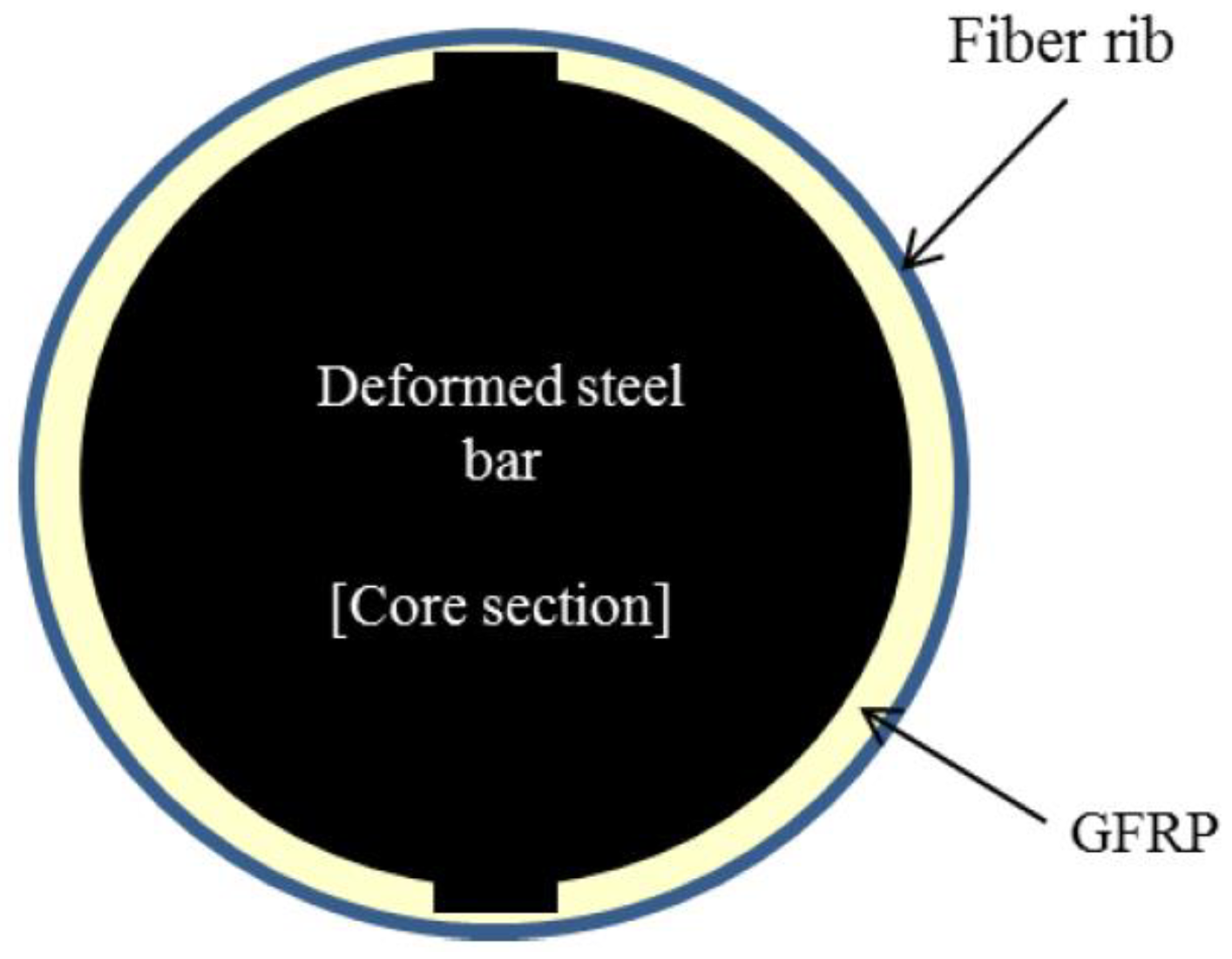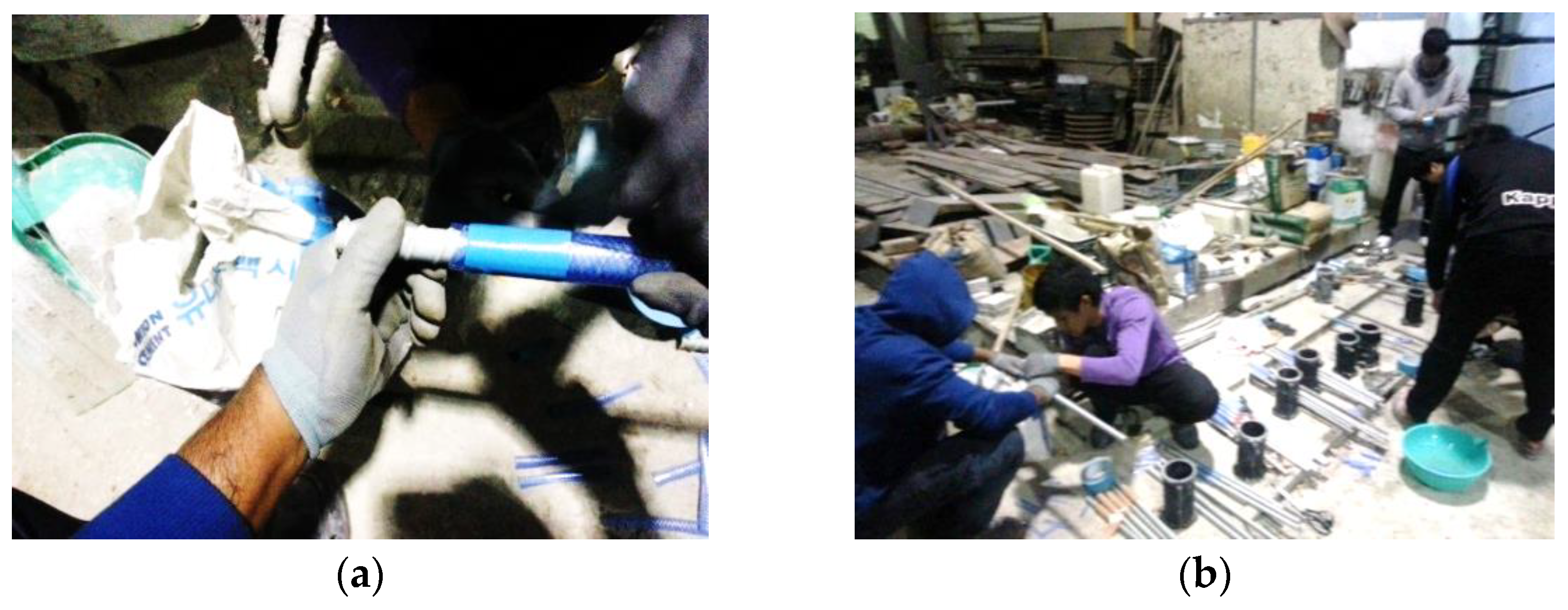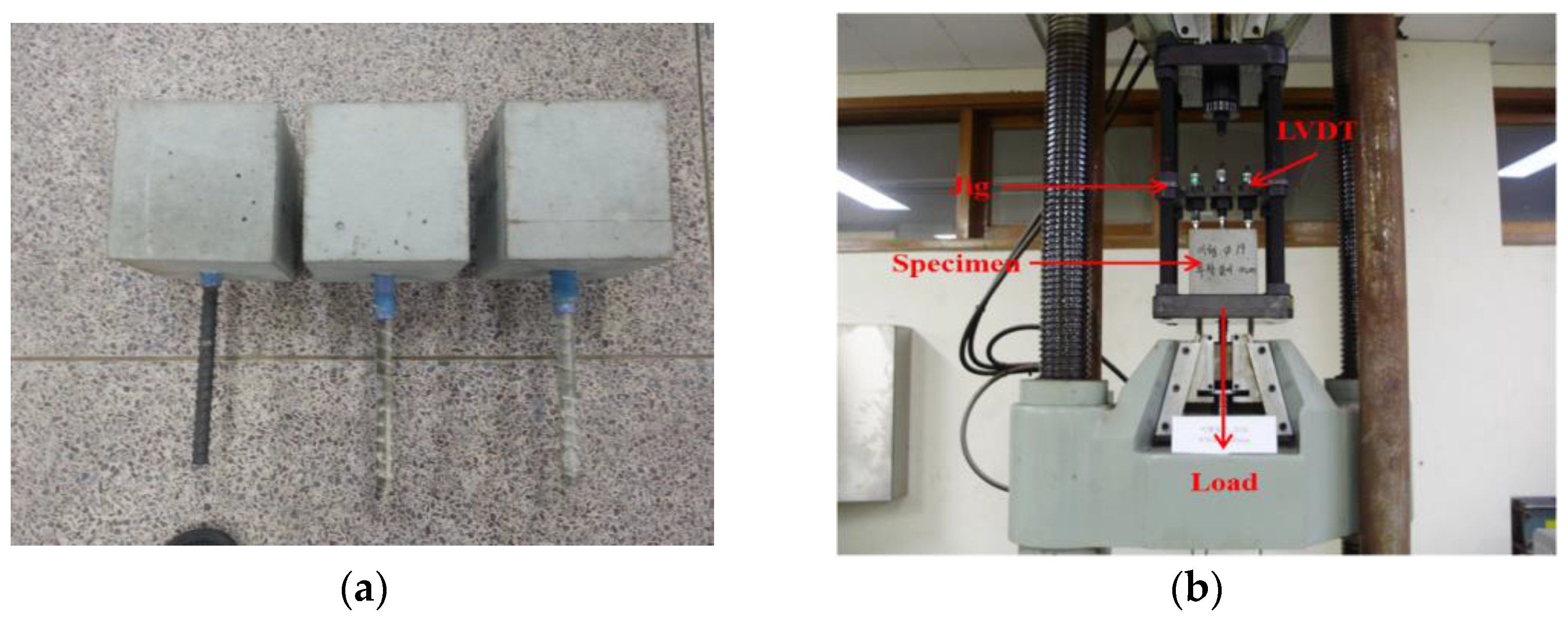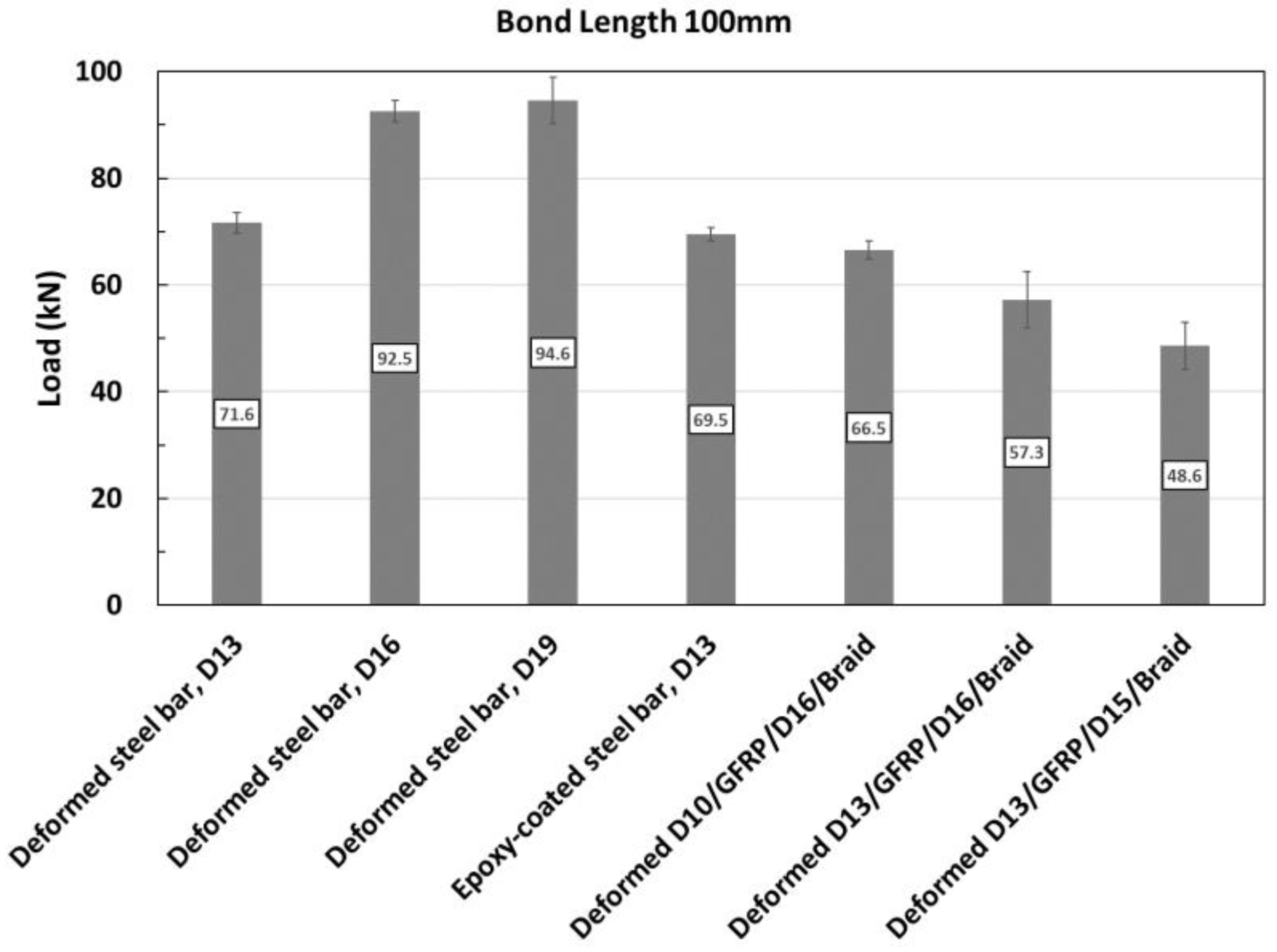3.1. Experimental Results of Deformed Steel Bars
The experimental results of the D13 deformed steel bar test showed that the maximum load was 52.2 kN when the bond length was 50 mm and 76.1 kN when it was 100 mm. In addition, the average bond strength was found to be approximately 25.4 MPa when the bond length was 50 mm. When the 50 mm bond length was tested, all three specimens exhibited pull-out failure due to cracking in the rebar and bonded surface. In contrast, the two specimens with a bond length of 100 mm exhibited tensile failure, in which the rebar yielded first, instead of pull-out failure. The experimental results of the D13 deformed steel bar are shown in
Table 8.
The experimental results of the D16 deformed steel bar tests show that the maximum load was 64.5 kN when the bond length was 50 mm and 95.0 kN when it was 100 mm. The average bond strengths were approximately 23.7 and 18.4 MPa when the bond lengths were 50 and 100 mm, respectively. Two specimens with a 50 mm bond length exhibited splitting failure of concrete, and one specimen showed pull-out failure. All three specimens with a 100 mm bond length exhibited concrete splitting failure, not pull-out failure. The experimental results of the D16 deformed steel bar test are shown in
Table 9.
The experimental results of the D19 deformed steel bar tests showed that the maximum load was 65.3 kN when the bond length was 50 mm and 103.7 kN when it was 100 mm. In addition, the average bond strengths were approximately 25.0 and 15.8 MPa when the bond lengths were 50 and 100 mm, respectively. In the case of a 50 mm bond length, two specimens exhibited concrete splitting failure, while one specimen showed rebar pull-out failure and splitting failure simultaneously. Similarly, for the 100 mm bond length steel bars, two specimens exhibited splitting failure and one specimen showed both pull-out and splitting failure. The experimental results of the D19 deformed steel bar are shown in
Table 10.
3.3. Experimental Results of the GFRP Hybrid Rebars
The experimental results of the deformed D10/GFRP/D16/Braid rebar showed that the maximum load ranged from 33.9 to 44.5 kN when the bond length was 50 mm and from 70.0 to 63.2 kN when it was 100 mm. In addition, the average bond strengths were approximately 16.1 and 13.2 MPa when the bond lengths were 50 and 100 mm, respectively. All three 50 mm bond length specimens exhibited pull-out failure. Two 100 mm bond length specimens showed splitting failure, and one specimen exhibited pull-out failure. The experimental results of the deformed D10/GFRP/D16/Braid rebar are shown in
Table 12.
The experimental results of the deformed D13/GFRP/D16/Braid rebar showed that the maximum load ranged from 42.7 to 25.1 kN when the bond length was 50 mm and from 69.5 to 50.8 kN when it was 100 mm. In addition, the average bond strengths were approximately 14.4 and 11.4 MPa when the bond lengths were 50 and 100 mm, respectively. In the case of a 50 mm bond length, two specimens exhibited splitting failure and one specimen showed pull-out failure. In the case of a 100 mm bond length, two specimens showed pull-out failure and one specimen exhibited splitting failure. The experimental results of the deformed D13/GFRP/D16/Braid rebar are shown in
Table 13.
Results of the deformed D13/GFRP/D15/Braid rebar experiments show that the maximum load ranged from 33.4 to 18.7 kN when the bond length was 50 mm and from 57.4 to 39.9 kN when it was 100 mm. The average bond strengths were approximately 11.1 and 10.3 MPa when the bond lengths were 50 and 100 mm, respectively. All three 50 mm bond length specimens experienced pull-out failure. Two 100 mm bond length specimens showed pull-out failure and one specimen exhibited splitting failure.
Table 14 shows the experimental results of the deformed D13/GFRP/D15/Braid rebar. Typical modes of failure are shown in
Figure 6.
3.4. Analysis of the Bond Properties of Each Variable
When the bond length was 50 mm, the effect of the epoxy coating on bond strength was not significant for a rebar diameter of D13. In addition, the bond strength decreased slightly as the diameter increased. When the bond length was 100 mm, however, splitting failure occurred in every specimen with a deformed steel bar. In contrast, the epoxy-coated steel bar exhibited a bond strength of approximately 17.15 MPa through pull-out failure at D13. This indicates that the epoxy-coated steel bar has lower bond performance with concrete than with conventional deformed steel bars, which failed due to the rupture of the rebar, even though the bond length increased with the epoxy coating. In the case of D13, the epoxy coating interfered with the adhesion between the concrete and rebar at the bonding interface. Moreover, most of the bond strength was generated by the deformed pattern; the reduction in bond strength due to epoxy was not significant because the magnitude of the load that was actually applied was similar (70 kN).
In addition, the maximum load showed a tendency to increase with the diameter of the rebar. When the bond length was increased from 50 to 100 mm, the load of the D13 deformed steel bar increased by approximately 40%, but that of the D19 deformed steel bar increased by only approximately 25%. The epoxy-coated steel bar also exhibited a similar tendency. For a rebar diameter of D13, when the bond length was 50 mm, the deformed steel bar and the epoxy-coated steel bar exhibited pull-out failure. The deformed steel rebar ruptured when the bond length was increased to 100 mm, suggesting that there was sufficient bonding force on the concrete, while the epoxy-coated steel bar specimen showed splitting failure. This indicates that the deformed steel bar will secure sufficient bond strength as the bond length increases, but the epoxy-coated steel bar bonds insufficiently to the concrete.
Considering the same rebar outer diameter, D16, the bond strength of the GFRP hybrid rebar decreased to a level causing great concern. The bond strength slightly decreased as the bond length increased, but remained very low compared to the deformed steel bar. When the diameter of the internal rebar decreased, e.g., in the case of the deformed D10/GFRP/D16/Braid rebar, the bond strength was slightly higher than the D13 internal rebar. This indicates that bond properties improve with increased GFRP thickness, which corresponds to the outer surface. This was also confirmed by comparing specimens with different GFRP thicknesses on the same D13 internal rebar.
GFRP hybrid rebar bond testing results reveal that the shortcomings of the existing FRP rebars, such as degradation in modulus of elasticity, shear vulnerability, and brittle fracture, can be complemented because the main tension elements are rebars. In addition, the tensile performance can be improved by glass fibers on the surface. These current design standards can be easily applied. Due to the somewhat lower bond strength compared to conventional rebars, however, the mechanical properties, anchorage length, and connection characteristics required by the design standards require further study. The maximum loads of each variable based on bond length are shown in
Figure 7 and
Figure 8.
The epoxy-coated steel bar exhibited bond strengths similar to deformed steel bars with the same diameter. However, this result was obtained using a rebar diameter of D13, which is too small to be used in the field as flexural reinforcement. Therefore, it is necessary to compare and analyze cases with relatively larger rebar diameters.
In the case of the GFRP hybrid rebar with deformed steel bars inside, the bond properties were lower compared to deformed steel bars. The bond properties improved as the GFRP thickness on the outer surface of the rebar increased.













